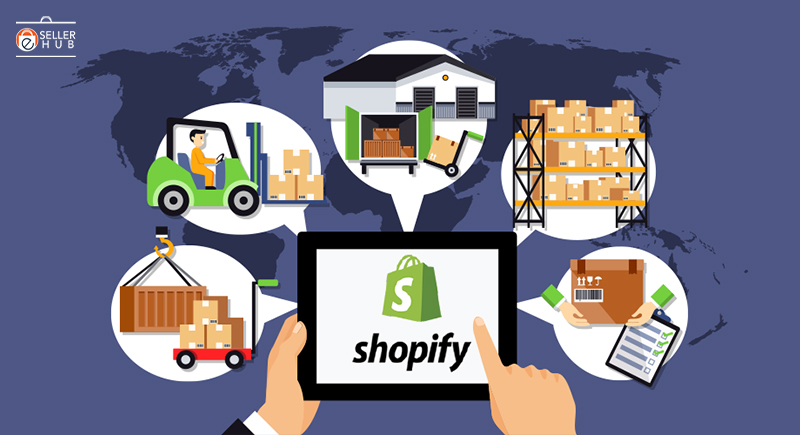Tips & Tricks For Shopify Inventory Management for 2024
- by eSellerHub

Shopify had recently announced that the company had crossed over one million merchants globally with online sales growth of 59% on its platform, which is more than twice the global eCommerce market growth. Shopify is flexible and offers merchants tools to operate their online stores, and thus, various businesses look up to it.
Inventory management is a critical aspect of any eCommerce company, and there lies the Shopify merchant’s success. Without establishing a solid foundation for accurate inventory tracking, online stores’ stock availability can face several serious problems.
Why is inventory management critical on Shopify?
Having a clear idea of an organized inventory helps avoid losses due to misplaced items, wastage, and returns. It also cuts down the overall inventory costs, improves Shopify fulfillment service, and makes way for better customer service.
Inventory management gives insight into:
- Customer behaviors and preferences
- Consumer interests and buying trends
- Business opportunities and new product ideas
- Financial performance and overall profitability
The best inventory management software for Shopify offers organizational support for brands of all sizes and volumes, thus, providing them the necessary framework for running a successful retail business. Omnichannel inventory management strategy is essential for brands that focus on becoming multichannel merchants and taking up omnichannel marketing practices.
While many brands go with Shopify as their eCommerce platform, there are quite a few challenges you may face when using it as your leading inventory management software. Here is a closer look at the Shopify inventory management competencies.
Three challenges of Shopify inventory management
Some of Shopify’s native inventory tracking features may be unexpectedly challenging for retailers having complex workflows or supply chains. Whether you have a direct-to-everywhere store approach or have specific requirements related to multichannel sales, it’s essential to identify these challenges and find suitable solutions tailored to manage your situation.
-
Products that don’t integrate into Shopify
Shopify has a long list of prohibited items. If your business sells products that do not fit into Shopify, then you will have to implement multichannel inventory management on multiple platforms manually. It leads to working with Shopify and your other sales channels separately than handling everything in one place.
It is a tedious and time-consuming process. It can also cause your company to oversell due to inconsistencies in inventory levels across various sales channels.
-
Automated inventory replenishment
When managing a more extensive SKU library, the inventory replenishment process unavoidably becomes more involved. The math is simple; more SKUs opens up more chances for out-of-stock, miscounts, or other inventory blunders.
The challenge is to identify an automatic purchase order generating system whenever the stock level reduces and suggest ideal order quantities for streamlining replenishment while preventing errors along the way. It should consolidate your entire current sales orders from Shopify and other sales channels that you sell.
-
Multichannel Functionalities
Multichannel brands need to have their inventory and business analytics consolidated under one roof. You should also be able to customize the way your inventory is shared across listings and profitability awareness around each SKU. To see how your products perform on every channel like Amazon, Walmart, Etsy, etc., one should know the channel-specific profitability beyond Shopify.
Some of the above functionalities are not characteristic of Shopify, and it can be a challenge. With the Shopify app store, merchants access the requisite tools to manage inventory smoothly and more efficiently, containing features like dropshipping and barcode technology.
Related Post: A Guide to Multi-Channel E-Commerce Software Development
Essential features to look for with Shopify inventory management software
As mentioned, Shopify has several apps available for integrating into e-commerce stores to offer advanced inventory control features. These third-party apps offer better functionalities when compared to native Shopify inventory management. Inventory management apps are central to a brand’s Shopify operations because they optimize the fulfillment service and inventory tracking process.
Shopify Inventory management apps helps to reduce the risk of over-stocking or overselling scenarios thereby improving the merchant’s operations. Over-stocking can lead to higher costs while overselling can let a merchant miss the opportunities for potential sales. Layering single inventory management software with Shopify is an ideal practice, and it is mostly preferred by quite a lot of major Shopify brands.
It is recommended to choose the one software possessing comprehensive features to avoid conflicting applications and streamline the number of apps connected to your store. Choosing an inventory management app comprises several aspects of your business, but certain features to prioritize include the following:
- Multichannel functionality by syncing your inventory across all your sales channels and warehouses accurately.
- Automatic Order routing to the best shipping provider and warehouse.
- Inventory control features to adjust the listing numbers based on your stock levels.
- Comprehensive, up-to-date analytics, and reporting across entire sales channels like stock levels, sales margins, and profitability.
- Automated purchase order creation based on sales volume and lead time, which includes recommended purchase volume and adjusting to meet forecasted demand.
- Managing Shared inventory across listings for the same product
- Locked inventory for holding of stocks and Cross-channel functionalities
Conclusion
It is essential to understand that multichannel brands need to have a cohesive, 360-degree view of their inventory and business analytics. Also, keep in mind that when more apps are connected to your store, the site may be slower. Ensure that you weigh all of Shopify’s inventory management app choices and go with the right software that meets your specific needs.
eSellerhub offers an excellent Shopify inventory management software that brings together and automates the entire inventory management operations. Our tools and functionalities can be tailored to meet multichannel business requirements and capable of expanding to several powerful native inventory management features presented in Shopify.